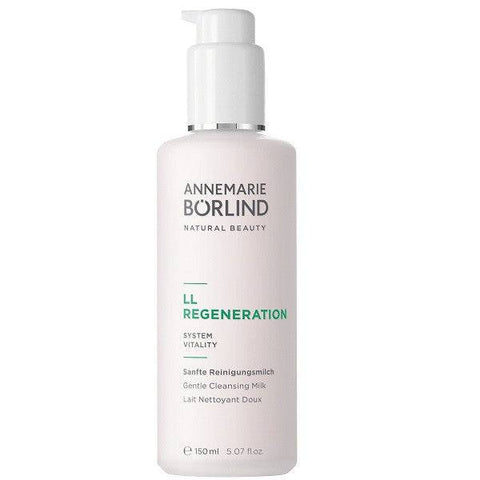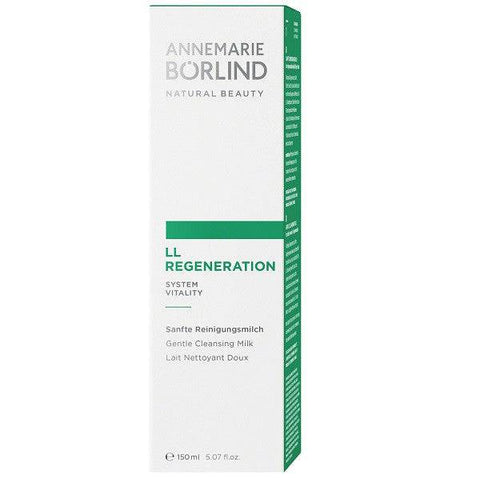

Annemarie Borlind
Annemarie Borlind LL Regeneration Gentle Cleansing Milk 150 ml
$45.95
$56.00
18%
Title
$45.95
$56.00you save $10.05
SKU: AMB-1019-001
ISBN/UPC: 4011061006586
Annemarie Borlind LL Regeneration Gentle Cleansing Milk
Gently cleanses the skin and restores lost oils.* For mature skin over 30. This mild emulsion has been especially formulated to meet the requirements of dry, poorly moisturized skin.* It gently removes dirt particles and makeup.* Caring botanical ingredients protect the skin from drying out and prepare it for subsequent skin care.*
Features:
- Vegan*
Recommended Use:
Apply to the face, throat and décolleté and allow to work for 30 seconds. Remove with dampened cosmetic sponges and rinse with lukewarm water.
*Disclaimer
These statements have not been evaluated by Health Canada or the FDA. This product is not intended to diagnose, treat, cure, or prevent any disease.
Ingredients:
-
AQUA [WATER]
- Deep spring water. Water from the red sandstone strata of the northern Black Forest in Germany. It is obtained from our own well at a depth of 165 meters, and is unchlorinated and naturally pure. Its function is to moisturize the surface of the skin and to act as a solvent for water-soluble ingredients and plant extracts.
-
CAPRYLIC/CAPRIC TRIGLYCERIDE
- A neutral vegetable oil. Obtained from the coconut (the fruit of the coconut palm). The oil has a long shelf life and offers exceptional skin-compatibility. It is rapidly absorbed and does not leave behind an oily shine on the skin.
-
GLYCERIN
- Glycerin. A component of all fats and oils. Glycerin has a moisturizing effect. For BÖRLIND, it is derived solely from vegetable oil.
-
POLYGLYCERYL-6 STEARATE
- An emulsifier from regrowing raw materials: plant glycerin and plant stearic acid.
-
SORBITAN STEARATE
- An emulsifier from regrowing raw materials: a compound of sorbitol (a natural sugar alcohol of plant origin with a moisturizing and moisture-retaining effect) and plant fatty acids from vegetable oil. Binds oil and water. Cares for and moisturizes the skin.
-
GLYCERYL STEARATE
- An emulsifier from regrowing raw materials: plant glycerin and plant stearic acid. Binds oil and water. Cares for the skin.
-
LAURYL GLUCOSIDE
- An active cleansing substance/surfactant. A very mild and very easily biodegradable surfactant of plant origin. A compound of natural coconut fatty acids.
-
SORBITOL
- Sorbitol. A natural sugar alcohol of plant origin that occurs naturally in many fruits. Also used in foodstuffs. Has a moisturizing and moisture-retaining effect.
-
PHENOXYETHANOL
- Phenoxyethanol. A nature-identical preservative. It occurs naturally in green tea and chicory.
-
GLYCINE SOJA OIL [SOYBEAN]
- Soybean oil. A vegetable oil that cares for the skin and makes it supple.
-
SUCROSE COCOATE
- An emulsifier from regrowing raw materials: cane or beet sugar and plant fatty acids from vegetable oil. Binds oil and water. Cares for and moisturizes the skin.
-
STEARIC ACID
- A fatty acid. A fatty component contained in various vegetable fats and oils. It smooths and cares for the skin, and has emulsifying properties.
-
AROMA [FRAGRANCE]
- Essential oils, distillates, perfume, fragrances, and aromatic substances. The collective term for everything that contains fragrances: from an individual essential oil through to perfume compositions made up of many different fragrances.
-
PALMITIC ACID
- A fatty acid. A fatty component contained in various vegetable fats and oils. It smooths and cares for the skin, and has emulsifying properties.
-
BENZYL ALCOHOL
- Benzyl alcohol. A declarable fragrance contained in perfume compositions, and a preservative.
-
XANTHAN GUM
- Xanthan. A polysaccharide produced by microorganisms from plant substrates containing sugar. A gelling/thickening agent that also stabilizes emulsions.
-
ARGININE
- Arginine. An amino acid: Amino acids are protein building blocks and occur in the natural moisturizing factors (NMFs) of human skin. They maintain the skin’s slightly acid surface film (protective acid mantle), and bind moisture.
-
ALCOHOL
- Pure, undenatured ethyl alcohol, potable alcohol. Obtained by fermenting plants containing starch or sugar. Alcohol is deployed as a solvent for extracts and various active ingredients. It also has a refreshing, astringent, toning and preservative effect, and stimulates the circulation.
-
HYPERICUM PERFORATUM EXTRACT
- St. John’s wort extract from organic farming. Has an astringent, soothing, protective and mild antimicrobial effect on the skin.
-
ECHINACEA ANGUSTIFOLIA EXTRACT
- Echinacea extract from organic farming. Extract of echinacea is by tradition considered to have anti-inflammatory, antibacterial, astringent and wound-healing properties.
-
CALENDULA OFFICINALIS FLOWER EXTRACT
- Calendula flower extract from organic farming. Calendula flowers have a wound-healing, soothing and anti-inflammatory effect.
-
LAURYL LACTATE
- A fatty acid ester. A light oil component of plant origin that cares for the skin. It is rapidly absorbed and non-greasy.
-
COUMARIN
- A fragrance. A declarable fragrance contained in perfume compositions.
-
HAMAMELIS VIRGINIANA LEAF EXTRACT
- Hamamelis/witch hazel leaf extract from organic farming. Refines the skin and has an anti-inflammatory effect.
-
LINALOOL
- A fragrance. A declarable fragrance contained in perfume compositions.
-
ASCORBYL PALMITATE
- Fat-soluble form of vitamin C. This fat-soluble form of vitamin C is more light- and temperature-resistant, and is converted into free vitamin C in the skin. It has an antioxidant effect, counteracts skin aging caused by free radicals and prevents emulsions from becoming rancid.
-
LECITHIN
- Lecithin. A substance similar to fat, with emulsifying properties. Can be found in vegetable oils from which it is derived. It cares for the skin and hair, and improves combability. Special lecithins can be made into liposomes in which active ingredients can be encapsulated and protected, improving their bioavailability when applied to the skin.
-
SALVIA OFFICINALIS LEAF EXTRACT [SAGE]
- Extract of sage leaves from organic farming. Has an anti-inflammatory, antimicrobial, astringent and antiperspirant effect. Deployed in anti-acne products and deodorants.
-
CHAMOMILLA RECUTITA FLOWER EXTRACT [MATRICARIA]
- Chamomile flower extract from organic farming. A medicinal plant with skin-soothing and anti-inflammatory properties. For the care of sensitive and delicate skin.
-
CETYL PALMITATE
- Cetyl palmitate. A fatty component of plant origin. A thickening agent. Cares for the skin.
-
TOCOPHEROL
- Vitamin E. Can be found in many vegetable oils. As an antioxidant it prevents these from becoming rancid. It also stabilizes cosmetics and protects the skin against free radicals induced by UV radiation, for example, thus forestalling premature, environment-related skin aging.
-
PANTHENYL ETHYL ETHER
- Panthenol and ethanol. An oil-soluble form of panthenol that is used in lipsticks, for example. Converts to pantothenic acid/vitamin B5 on the skin. It binds moisture and has a regenerating effect, and therefore wound-healing properties.
-
PHYTANTRIOL
- Phytantriol. Produced by oxidation of phytol (a component of chlorophyll), it has a moisturizing effect.
-
BISABOLOL
- (Alpha-)bisabolol. An anti-inflammatory, skin-soothing ingredient with an antimicrobial effect. Can be found in essential bergamot oil, chamomile oil and the oil of the candeia tree (vanillosmopsis erythropappa). For BÖRLIND, only bisabolol from sustainable, FSC-certified candeia plantations is used, in order to protect the Brazilian highland rainforests.
-
HYDROGENATED PALM GLYCERIDES CITRATE
- An emulsifier from regrowing raw materials: plant glycerin and vegetable fat plus citric acid. Binds oil and water. Cares for the skin.
-
PYRIDOXINE TRIPALMITATE
- Pyridoxine tripalmitate/vitamin B6 tripalmitate. Combined with plant palmitic acid, a fat-soluble form of pyridoxine/vitamin B6.
-
CITRIC ACID
- Citric acid. Derived by fermentation from corn substrate. Used to regulate the pH value of cosmetics.
-
*The declaration on the packaging prevails.
Listing the ingredients in accordance with INCI (the International Nomenclature of Cosmetic Ingredients) allows a uniform, language-independent declaration of ingredients throughout Europe. Please see the list above for an explanation of the INCIs.
